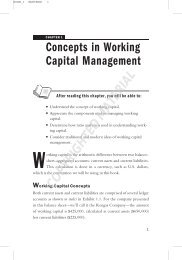ISSUE 5 2008 - Sweet & Maxwell
ISSUE 5 2008 - Sweet & Maxwell
ISSUE 5 2008 - Sweet & Maxwell
Create successful ePaper yourself
Turn your PDF publications into a flip-book with our unique Google optimized e-Paper software.
Crim. L.R. Sentencing 401<br />
were to be made. The process by which the court assessed a defendant’s proceeds of<br />
drug trafficking was to be distinguished from the process for assessing the amount<br />
to be recovered under a confiscation order by virtue of s.5. Section 5 provided<br />
that the amount to be recovered under a confiscation order should be the amount<br />
the Crown Court assessed to be the value of the defendant’s proceeds of drug<br />
trafficking, unless the court was satisfied that the amount that might be realised at<br />
the time the confiscation order was made was less than that amount. In that event,<br />
the amount of the confiscation order should be the amount appearing to the court to<br />
be the amount that might be realised or a nominal amount. The amount that might<br />
be realised at the time a confiscation order was made was the total value of all the<br />
realisable property held by the defendant. The effect of the provisions was that prima<br />
facie the court was required to award recovery of the full value of the defendant’s<br />
proceeds of drug trafficking. The court had no power to make an order for any lesser<br />
sum unless it was satisfied that the total of the value at the time the confiscation<br />
order was made of all property held by the defendant was less than the value of the<br />
proceeds as assessed according to s.4. If a defendant failed to satisfy the court of the<br />
value of that realisable property, the court was bound to make a confiscation order<br />
in the full value of his proceeds. A defendant should not, if the statutory scheme<br />
was properly followed, be able to avoid an order recovering the full value of his<br />
proceeds unless he identified the realisable property he held. If he refused to do so,<br />
the court had no option but to order the full amount. It was not open to the Crown<br />
or the defendant to reach an agreement which purported to confer on the Crown<br />
Court an authority inconsistent with the court’s obligations imposed by s.5. That<br />
was not to say that the Crown and the defendant could not reach an agreement<br />
as to the matters which formed the foundation of a confiscation order. It would be<br />
disastrous if it were otherwise. Throughout the period of the operation of the 1994<br />
Act, agreements had been reached between prosecuting authorities and defendants<br />
without which proceedings in the Crown Court would grind to a halt.<br />
It was important to emphasise that any agreement must be within the framework<br />
of the statutory scheme and not inconsistent with it. When the original confiscation<br />
order was made, the court issued a certificate in accordance with s.5 to the effect<br />
that the value of the defendant’s proceeds of drug trafficking was £6 million and<br />
that the amount that might be realised at the time of the making of the order was<br />
£3,458,806. The certificate stated that relevant information regarding the amounts<br />
would be obtained from an officer of HM Customs and Excise. The only source<br />
of information at the time the order was made was a statement made by the officer<br />
under s.11; this was the only source consistent with the statute for determining<br />
the property which formed the basis of the valuation. The statement dealt with the<br />
proceeds received by the defendant and the value of his realisable property. This<br />
led to confusion. The essential function of the prosecutor’s s.11 statement was to<br />
determine whether the defendant had benefited from drug trafficking and to assess<br />
the value of his proceeds. It was not part of the prosecutorial function to quantify<br />
the value of realisable property. That was because it was for the defendant to satisfy<br />
the court that the total value of the realisable property held by him (including gifts<br />
he had made) was less than the total value of his proceeds. For that reason, the<br />
prosecutor’s statement need do no more than assess the full value of the proceeds,<br />
leaving the defendant to persuade the court that his realisable property was to be<br />
valued at a lower figure. The fact that a prosecutor’s statement condescended to<br />
identify property held by the defendant and quantify its value did not in any way<br />
© SWEET &MAXWELL






